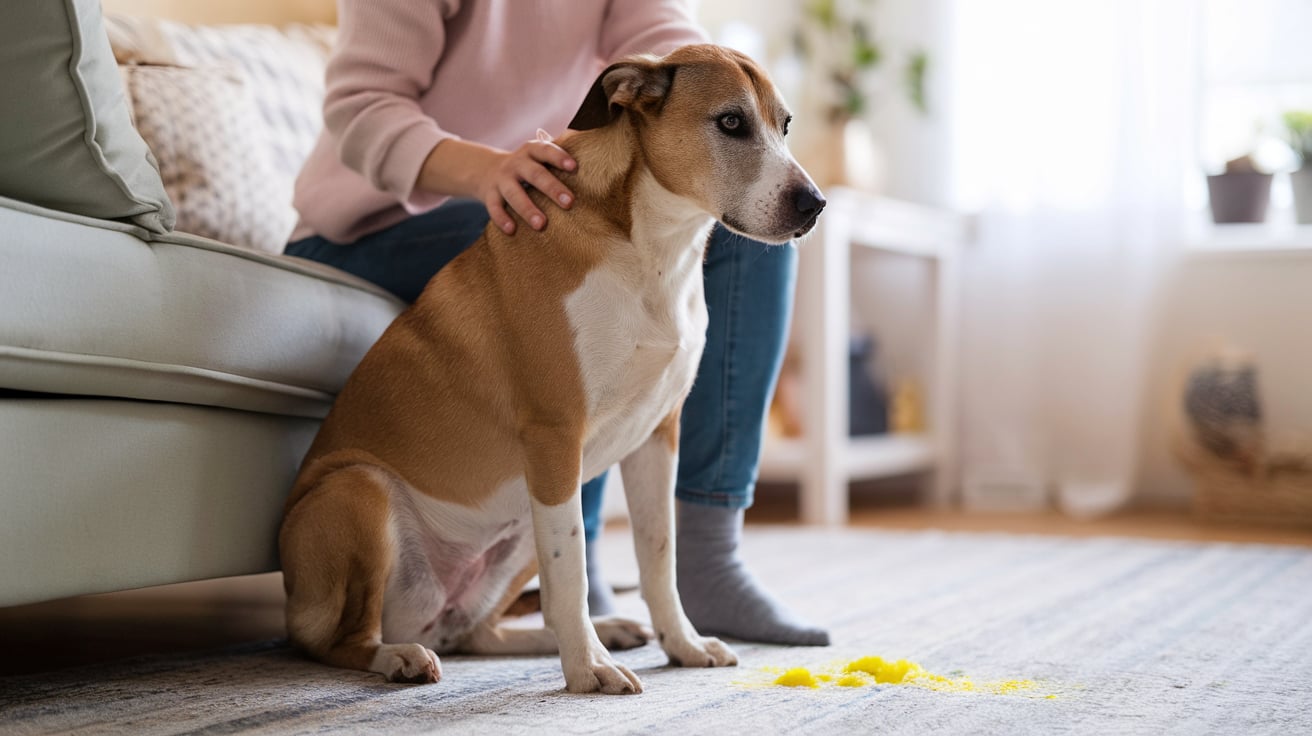Introduction
As a veterinarian, one of the most common concerns pet owners bring up is their dog vomiting, especially when it appears yellow. While this can be alarming, it’s important to understand that not all instances of yellow vomit indicate a severe problem. However, knowing the potential causes and when to seek professional help is crucial for your dog’s health and well-being.
Yellow vomit in dogs often contains bile, a digestive fluid produced in the liver and stored in the gallbladder. This fluid helps break down food in the small intestine, but when a dog vomits bile, it usually means their stomach is empty, leading to bile entering the stomach. Although this might seem harmless, chronic episodes could signal underlying issues that need attention.
Understanding the cause of your dog’s yellow vomit is important because it can range from mild issues, such as hunger or eating too fast, to more serious conditions like gastrointestinal disease or liver problems. Being aware of the triggers and learning to identify when it’s time to contact a vet can make a significant difference in your dog’s health and prevent minor issues from becoming major concerns.
When should you be concerned? If your dog’s yellow vomit occurs once and your dog returns to normal behavior, it may not be a cause for worry. However, if it happens repeatedly, is accompanied by other symptoms like lethargy, diarrhea, or a loss of appetite, or if the vomit contains blood, it’s important to contact your veterinarian immediately.
What Does Yellow Vomit in Dogs Mean?
Yellow vomit in dogs is typically a sign that they are expelling bile. The liver produces bile, a yellow-green digesting fluid that is kept in the gallbladder. Its primary role is to help break down food, especially fats, in the small intestine. When a dog vomits bile, it usually indicates that the stomach is empty and there is nothing to absorb this fluid, causing it to be regurgitated. While a single occurrence may not be serious, repeated episodes can indicate a more significant problem.
To understand why this happens, it’s helpful to know how the digestive system works in dogs. After being eaten, food travels from the mouth into the stomach, where stomach acids break it down. From there, it moves into the small intestine, where bile and digestive enzymes help further digest and absorb nutrients. Normally, bile stays in the small intestine, but when a dog’s stomach remains empty for long periods, bile can backflow into the stomach, irritating the stomach lining and triggering vomiting.
Bile appears in vomit when a dog has an empty stomach because there is no food for the bile to work on. This often happens in the morning or late at night if a dog has gone too long between meals. Hunger-induced vomiting is fairly common, but chronic or excessive vomiting of bile can point to underlying gastrointestinal issues, like inflammatory bowel disease, food allergies, or blockages.
Common Causes of Yellow Vomit in Dogs
Hunger or Empty Stomach
One of the most frequent reasons for yellow vomit in dogs is simply an empty stomach. When dogs go too long without food, bile can build up in the stomach and cause irritation, leading to vomiting. This is most commonly seen in the morning, after a long night without eating. While occasional bile vomiting due to hunger isn’t usually harmful, frequent episodes can become a concern if left unaddressed.
Solutions: To prevent this, adjusting your dog’s feeding schedule can help. Offering smaller, more frequent meals throughout the day ensures their stomach never remains empty for too long. You can also avoid morning vomiting by feeding your dog a little meal before bed. This approach helps keep bile from irritating the stomach lining.

Gastrointestinal Irritation
Diet changes, food sensitivities, or even foreign objects ingested by dogs can lead to gastrointestinal irritation, which may trigger yellow vomiting. Sudden changes in a dog’s diet, introducing new foods too quickly, or feeding foods that don’t agree with your dog’s digestive system can all lead to irritation and bile vomiting. Foreign objects, such as toys or household items, may also cause digestive upset if swallowed.
Solutions: To avoid gastrointestinal irritation, make dietary adjustments gradually. Slowly introduce new foods over several days to give your dog’s stomach time to adjust. Also, avoid feeding your dog table scraps or foods that could upset their stomach. If foreign objects are suspected, it’s important to consult a veterinarian to prevent further complications.
Bilious Vomiting Syndrome
Bilious Vomiting Syndrome (BVS) occurs when bile irritates the stomach lining, usually in the morning or after long periods of fasting. It is similar to hunger-induced vomiting but can happen even if a dog is otherwise healthy. Dogs with BVS often vomit in the early hours of the morning because their stomachs have been empty for an extended time.
Solutions: Managing Bilious Vomiting Syndrome typically involves offering a small meal before bedtime to keep the stomach full overnight. A low-fat, easily digestible diet can also help reduce bile production and minimize irritation. Consult with your veterinarian to determine the best dietary plan for dogs with BVS.
Acid Reflux
Dogs who suffer from acid reflux, sometimes referred to as gastroesophageal reflux, may also vomit yellow bile. When stomach acids flow back into the esophagus, they can irritate both the stomach and the esophagus, causing discomfort and vomiting. Dogs with acid reflux may vomit bile, especially after lying down for long periods.
Solutions: To manage acid reflux, dietary changes are essential. Feeding smaller, more frequent meals can prevent the stomach from becoming too full, reducing acid production. Raising the dog’s food and water bowls to a comfortable height can also help improve their feeding posture and prevent reflux.
Parasites or Infections
Parasites, such as roundworms or hookworms, and gastrointestinal infections can also cause vomiting in dogs. These parasites can irritate the digestive tract, leading to yellow bile vomiting and other symptoms like diarrhea, weight loss, and lethargy. Infections, whether bacterial, viral, or parasitic, may also cause vomiting as the body tries to expel the harmful agents.

Solutions: If parasites or infections are the cause, it’s important to visit your veterinarian for a proper diagnosis. Treatments may include medications, deworming protocols, or antibiotics, depending on the underlying issue. Regular deworming and parasite control measures are essential for preventing these issues.
Liver or Pancreatic Issues
In more serious cases, yellow vomit may be a sign of liver disease or pancreatitis. Liver disease can cause bile buildup and vomiting as the liver struggles to process bile properly. Pancreatitis, an inflammation of the pancreas, can also cause vomiting, along with other symptoms such as abdominal pain, loss of appetite, and diarrhea. Both conditions require immediate veterinary attention.
Solutions: If you suspect liver or pancreatic issues, immediate veterinary care is essential. Your vet will likely perform diagnostic tests such as blood work, ultrasounds, or X-rays to determine the underlying cause. Treatment may include specialized diets, medications, and in severe cases, hospitalization.
When to Worry:
While occasional yellow vomit is common in dogs and can often be managed with simple dietary adjustments, certain symptoms signal a more serious problem that requires veterinary attention. Understanding when to seek help can prevent small issues from escalating into severe health concerns.
Persistent Vomiting
If your dog is vomiting yellow bile repeatedly, it’s a sign that something more serious could be happening. If left addressed, frequent or persistent vomiting can result in dehydration and other issues. Vomiting more than once in a day, or over multiple days, is cause for concern, especially if there’s no obvious trigger like an empty stomach or dietary changes. When vomiting doesn’t stop after feeding or modifying your dog’s diet, it’s time to contact your vet.
Lethargy and Lack of Appetite
In addition to vomiting, if your dog is unusually lethargic or showing a lack of appetite, this could indicate a more significant health issue. A normally active dog that suddenly becomes listless or refuses to eat may be dealing with a serious underlying condition. Dogs often mask their discomfort, so any significant change in energy levels or eating habits, particularly when paired with vomiting, should be taken seriously.
Blood in Vomit or Other Alarming Symptoms
If you notice blood in your dog’s vomit, whether it’s bright red or dark and coffee-ground-like, you should seek immediate veterinary care. Blood in the vomit can be a sign of internal bleeding, ulcers, or other severe gastrointestinal problems. Other alarming symptoms include diarrhea, excessive drooling, sudden weight loss, or signs of abdominal pain like whining, pacing, or guarding the stomach area.

Timeline for Seeking Veterinary Care
In most cases, if your dog vomits yellow bile once and returns to normal behavior, you can monitor the situation and make minor dietary adjustments. However, if vomiting continues beyond 24 hours, or if it is accompanied by any of the above symptoms (lethargy, lack of appetite, blood in vomit), it’s crucial to consult your veterinarian as soon as possible. Delaying veterinary care could worsen the condition and lead to more significant health problems, so prompt attention is key to ensuring your dog’s well-being.
Home Remedies and Immediate Care Tips
When your dog experiences yellow vomiting, there are a few home remedies you can try to help them recover. One of the most effective methods is offering a bland diet. A simple meal of boiled chicken (without skin or seasoning) and plain white rice can help soothe your dog’s stomach. These foods are gentle on the digestive system and can give your dog’s stomach a break while still providing necessary nutrients. Gradually reintroduce their regular food after a few days, once their vomiting subsides.
Hydration is also crucial. Vomiting can quickly lead to dehydration, especially if it’s persistent. Encourage your dog to drink small amounts of water frequently to avoid overwhelming their stomach. If your dog is hesitant to drink, offering ice cubes to lick can be an easier way to keep them hydrated without triggering more vomiting.

While managing your dog’s symptoms at home, keep a close eye on their behavior. Monitor them for any signs of improvement, such as a return to their usual energy levels and appetite, or worsening, such as repeated vomiting, lethargy, or discomfort. If symptoms persist or worsen despite your efforts, it’s important to seek veterinary care.
Preventing Yellow Vomit in the Future
To prevent yellow vomit from recurring, it’s essential to maintain a regular feeding schedule. Dogs who go too long between meals are more likely to vomit bile due to an empty stomach. Feeding smaller, more frequent meals throughout the day can help prevent this. Consider offering a small snack before bedtime to avoid early morning vomiting.
Avoiding fatty foods is another key factor. High-fat meals can be difficult for dogs to digest and can irritate their digestive tract, leading to bile vomiting. Stick to a balanced diet, and if you’re not sure what’s best for your dog, consult your veterinarian for recommendations.
Managing stress and anxiety in your dog is also important for their digestive health. Dogs who experience anxiety or stress may develop stomach problems, leading to vomiting. Creating a calm and comfortable environment, offering regular exercise, and engaging in mental stimulation can help reduce anxiety and improve overall well-being.
Lastly, routine veterinary check-ups are essential to keep your dog’s digestive system in good shape. Regular exams allow your vet to spot any potential health issues early and ensure your dog’s diet and lifestyle are supporting their digestive health.
Conclusion
Yellow vomit in dogs is often caused by bile, typically due to an empty stomach or minor digestive irritation. Common causes include hunger, dietary changes, gastrointestinal irritation, and conditions like Bilious Vomiting Syndrome or acid reflux. While home remedies like a bland diet and hydration can help, it’s important to monitor your dog for signs of improvement or worsening symptoms.
It is essential to see a veterinarian if vomiting continues or if any other worrisome signs appear, such as lethargy or blood in the vomit. By maintaining a regular feeding schedule, avoiding fatty foods, managing stress, and scheduling routine vet check-ups, you can prevent future episodes and keep your dog healthy and happy.
FAQs
What causes yellow vomit in dogs?
Yellow vomit in dogs is typically caused by bile, a digestive fluid produced by the liver and stored in the gallbladder. It often occurs when a dog’s stomach is empty, leading to bile being expelled during vomiting. Common causes include hunger, gastrointestinal irritation, or conditions like acid reflux and Bilious Vomiting Syndrome.
Is yellow vomit in dogs always a cause for concern?
Not always. Occasional vomiting of yellow bile can happen when a dog’s stomach is empty, especially if they haven’t eaten in a while. However, frequent or persistent vomiting can indicate more serious issues such as digestive problems, liver disease, or infections and should be evaluated by a veterinarian.
What food should I give my dog that has just vomited up yellow bile?
A bland diet consisting of boiled chicken (unseasoned) and plain white rice is usually recommended. This helps soothe your dog’s stomach and provides easy-to-digest nutrients. Gradually reintroduce their normal food after a few days when the vomiting stops.
How can I prevent my dog from vomiting yellow bile in the future?
To prevent future episodes, maintain a regular feeding schedule with smaller, more frequent meals. Avoid fatty foods and sudden changes in diet. Providing a small snack before bedtime can also help prevent early morning vomiting.
When should I be worried about yellow vomit?
You should be concerned if your dog is vomiting frequently, shows signs of lethargy, loses appetite, or if you see blood in their vomit. These symptoms may indicate more serious health issues, such as liver disease, pancreatitis, or gastrointestinal infections, and warrant immediate veterinary attention.
Can stress cause my dog to vomit bile?
Yes, stress and anxiety can affect a dog’s digestive system, leading to bile vomiting. Managing your dog’s stress through regular exercise, a stable routine, and a calm environment can help prevent this.
What is Bilious Vomiting Syndrome in dogs?
Bilious Vomiting Syndrome occurs when bile irritates a dog’s stomach, usually after long periods without food. It’s more common in the early morning or late at night when the stomach is empty. This can often be managed with a small meal before bedtime and a low-fat diet.
Can acid reflux cause my dog to vomit yellow bile?
Yes, acid reflux can lead to bile vomiting in dogs. When stomach acid flows back into the esophagus, it can irritate both the stomach and esophagus, causing discomfort and vomiting. Adjusting feeding times and raising the food bowl to improve posture during meals can help manage this condition.
How do parasites cause yellow vomit in dogs?
Parasites like roundworms and hookworms can irritate the digestive tract and lead to vomiting, sometimes with bile. Infections caused by parasites can also trigger vomiting. Deworming treatments and regular veterinary check-ups can help prevent parasite-related vomiting.
What should I do if my dog vomits yellow bile but is otherwise healthy?
If your dog vomits bile occasionally but shows no other signs of illness, try adjusting their feeding schedule or offering smaller, more frequent meals.It is important to get in touch with your veterinarian for a comprehensive evaluation if the vomiting continues or gets worse.
